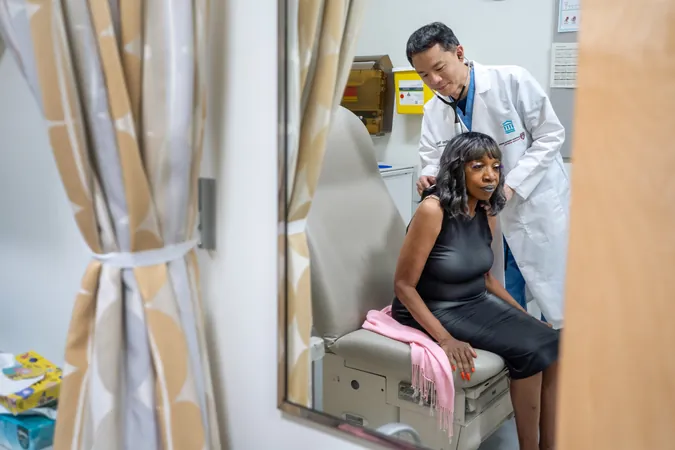
Rethinking Lung Cancer Screening: Duration Trumps Intensity for Smokers
2024-09-18
Author: Jia
Rethinking Lung Cancer Screening: Duration Trumps Intensity for Smokers
When it comes to lung cancer screening, the traditional guideline of assessing "pack-years" — the number of packs smoked per day multiplied by the number of years smoked — may not be the most effective method. Researchers from Harvard Medical School and Massachusetts General Hospital argue that focusing solely on the number of years a person has smoked, rather than the number of cigarettes per day, could drastically improve early detection rates of this deadly disease, particularly among Black patients who are often diagnosed at later stages.
This groundbreaking study has revealed that the current guidelines, as set by the U.S. Preventive Services Task Force, may overlook a significant number of lung cancer cases. Only those who smoke a pack a day for 20 years qualify for screening, meaning that many others, including those who might smoke less intensely over longer periods, are missed. This could perpetuate health disparities, as Black patients often have lower smoking intensity but experience higher mortality rates from lung cancer.
Published in the Journal of Clinical Oncology, the study proposes a shift to an annual screening recommendation for anyone who has smoked for at least 20 years, irrespective of daily cigarette intake. This change could increase the number of patients eligible for screening and help remove the existing racial disparities in lung cancer detection. "We found that it completely eliminated the racial disparity in the proportion of lung cancer patients who would have qualified," says Alexandra Potter, the study's lead author.
The distinction between smoking duration and intensity is crucial. The complexity of the pack-year measurement can confuse patients, as it requires individuals to accurately remember their smoking habits over decades. This variability can lead to discrepancies in risk assessment that are not aligned with the actual likelihood of developing lung cancer. Interestingly, studies suggest that smoking duration may correlate more strongly with cancer risk than intensity, debunking the traditional assumptions.
The research highlights a stark contrast in screening eligibility. When comparing the two studies—Southern Community Cohort Study and Black Women’s Health Study—only 58% of Black patients qualified under existing guidelines, compared to 74% of white patients. However, when applying the proposed 20-year duration guideline, over 80% of both Black and white patients would be eligible for screening.
The study illustrates that white smokers tend to smoke heavier amounts, which can skew the data, resulting in lower eligibility rates for Black smokers, who may smoke less but, nonetheless, for longer durations. "Our analysis showed the median number of cigarettes smoked among Black patients with lung cancer was almost half that of their white counterparts," Potter explains.
Amidst these findings, other barriers to lung cancer screening persist. Smoking continues to be the leading cause of lung cancer, responsible for approximately 85% of cases. Yet, despite the high mortality rate, a staggering 80% of those who qualify for screening remain unaware of their eligibility. And among those who do know, only 5% to 19% follow through with the procedure, in stark contrast to screening rates for breast, cervical, and colon cancers.
Potter also notes the logistical challenges: unlike other cancer screenings, lung cancer screening often requires a prior healthcare visit, adding another layer of difficulty that can deter patients. The screening process itself, however, is straightforward and non-evasive, involving a CT scan that can quickly detect potential tumors.
A real-life example from the study involved a patient who smoked only three cigarettes a day for years, totaling just 8.4 pack-years, disqualifying her from standard screening. Fortunately, she participated in a clinical trial designed specifically for high-risk individuals and was diagnosed with aggressive cancer nodules through screening that potentially saved her life.
As discussions around cancer screening continue to evolve, experts advocate for a thorough reconsideration of existing guidelines. "We're hopeful that these findings prompt a re-evaluation of pack-year metrics and ultimately lead to more effective screening for all individuals at risk of lung cancer," Yang concludes.
This potential paradigm shift in screening for lung cancer might just save thousands of lives — especially those historically overlooked in the process.


 Brasil (PT)
Brasil (PT)
 Canada (EN)
Canada (EN)
 Chile (ES)
Chile (ES)
 España (ES)
España (ES)
 France (FR)
France (FR)
 Hong Kong (EN)
Hong Kong (EN)
 Italia (IT)
Italia (IT)
 日本 (JA)
日本 (JA)
 Magyarország (HU)
Magyarország (HU)
 Norge (NO)
Norge (NO)
 Polska (PL)
Polska (PL)
 Schweiz (DE)
Schweiz (DE)
 Singapore (EN)
Singapore (EN)
 Sverige (SV)
Sverige (SV)
 Suomi (FI)
Suomi (FI)
 Türkiye (TR)
Türkiye (TR)